Locomotive classification on the Pennsylvania Railroad took several forms. Early on, steam locomotives were given single-letter classes. As the 26 letters were quickly assigned, that scheme was abandoned for a more complex system. This was used for all of the PRR's steam locomotives, and — with the exception of the final type bought — all electric locomotives also used this scheme.

The Pennsylvania Railroad (PRR) K4 4-6-2 "Pacific" was its premier passenger-hauling steam locomotive from 1914 through the end of steam on the PRR in 1957.
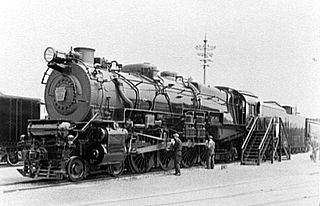
The M1 was a class of steam locomotive of the Pennsylvania Railroad (PRR). It was a class of heavy mixed-traffic locomotives of the 4-8-2 "Mountain" arrangement, which uses four pairs of driving wheels with a four-wheel guiding truck in front for stability at speed and a two-wheel trailing truck to support the large firebox needed for sustained power. Although built for both passenger and freight work, they spent most of their service lives hauling heavy high-speed freight trains. Many PRR men counted the M1 class locomotives as the best steam locomotives the railroad ever owned.
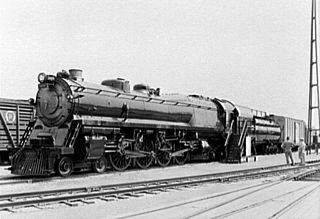
A 4-4-4-4 steam locomotive, in the Whyte notation for describing locomotive wheel arrangements, has a four-wheel leading truck, two sets of four driving wheels, and a four-wheel trailing truck. While it would be possible to make an articulated locomotive of this arrangement, the only 4-4-4-4s ever built were duplex locomotives—with two sets of cylinders driving two sets of driven wheels in one rigid frame, essentially a 4-8-4 with divided drive.

The Pennsylvania Railroad's S2 class was a steam turbine locomotive designed and built in a collaborative effort by Baldwin Locomotive Works and Westinghouse Electric & Manufacturing Company, as an attempt to prolong the dominance of the steam locomotive by adapting technology that had been widely accepted in the marine industry. One was built, #6200, delivered in September 1944. The S2 was the sole example of the 6-8-6 wheel arrangement in the Whyte notation, with a six-wheel leading truck keeping the locomotive stable at speed, eight powered and coupled driving wheels, and a six-wheel trailing truck supporting the large firebox. The S2 used a direct-drive steam turbine provided by the Westinghouse Electric & Manufacturing Company, geared to the center pair of axles with the outer two axles connected by side rods; the fixed gear ratio was 18.5:1. Such design was to prevent energy loss and S2 achieved a mechanical efficiency of 97% which means only 3% of steam energy was lost within the propulsion equipment. The disadvantage of a direct-drive steam turbine was that the turbine could not operate at optimal speeds over the locomotive's entire speed range. The S2 was the largest, heaviest and fastest direct-drive turbine locomotive design ever built.
The Pennsylvania Railroad's class K5 were experimental 4-6-2 "Pacific" types, built in 1929 to see if a larger Pacific than the standard K4s was worthwhile. Two prototypes were built, #5698 at the PRR's own Altoona Works, and #5699 by the Baldwin Locomotive Works. Although classified identically, the two locomotives differed in many aspects, as detailed below. They were both fitted with a much fatter boiler than the K4s, but dimensionally similar to those of the I1s 2-10-0 "Decapods". Most other dimensions were enlarged over the K4s as well; the exceptions being the 70 square feet (6.5 m2) grate area and the 80 in (2.032 m) drivers.

The PRR S1 class steam locomotive was a single experimental duplex locomotive of the Pennsylvania Railroad. It was designed to demonstrate the advantages of duplex drives espoused by Baldwin Chief Engineer Ralph P. Johnson. It was the longest and heaviest rigid frame reciprocating steam locomotive that was ever built. The streamlined Art Deco styled shell of the locomotive was designed by Raymond Loewy.
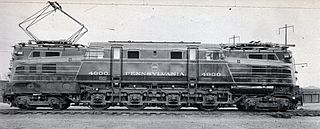
The Pennsylvania Railroad's class R1 comprised a single prototype electric locomotive constructed in 1934 by the Baldwin Locomotive Works of Philadelphia, Pennsylvania, US, with the electrical equipment by Westinghouse.
The Pennsylvania Railroad class Q1, #6130, was a single experimental steam locomotive designed for dual service. The locomotive entered service in 1942, and retired in 1949 after accumulating a relatively low 165,000 service miles.

The Pennsylvania Railroad's class Q2 comprised one prototype and twenty-five production duplex steam locomotives of 4-4-6-4 wheel arrangement built between 1944 and 1945.
Class E6 on the Pennsylvania Railroad was the final type of 4-4-2 "Atlantic" locomotive built by the railroad, and second only to the Milwaukee Road's streamlined class A in size, speed and power. Although quickly ceding top-flight trains to the larger K4s Pacifics, the E6 remained a popular locomotive on lesser services and some lasted to the end of steam on the PRR. One, #460, called the Lindbergh Engine, is preserved at the Railroad Museum of Pennsylvania. It was moved indoors to begin preparations for restoration on March 17, 2010. On January 10, 2011, PRR #460 was moved to the museum's restoration shop for a two- to three-year project, estimated to cost $350,000. The engine is listed in the National Register of Historic Places.

Pennsylvania Railroad Class L1s were 2-8-2 "Mikado"-type steam locomotives that were used on the Pennsylvania Railroad during the early twentieth century. These 574 locomotives were manufactured between 1914 and 1919 by the railroad's own Juniata Shops as well as the Baldwin Locomotive Works (205) and the Lima Locomotive Works (25).

The Trail Blazer was a deluxe all-coach train, inaugurated between New York and Chicago via Pittsburgh, Pennsylvania on 17:25 schedule operated by the Pennsylvania Railroad. The trains departed New York City and Chicago every day at 4:30 pm and 3:00 pm, respectively, and arrived at the destination the next morning. The Trail Blazer was one of the first all-coach trains to provide premium services comparable to a Pullman train. The Trail Blazer name was first used in 1927 for the East St. Louis-Pittsburgh preferred freight VL-6.
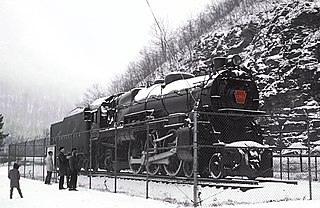
Pennsylvania Railroad 1361 is a 4-6-2 K4 "Pacific" type steam locomotive built in May 1918 by the Pennsylvania Railroad's (PRR) Juniata Shops in Altoona, Pennsylvania. It hauled mainline passenger trains in Pennsylvania and commuter trains in Central New Jersey on the PRR until its retirement from revenue service in 1956. Restored to operating condition for excursion service in 1987, No. 1361 and its only surviving sister locomotive, No. 3750, were designated as the official state steam locomotives by the Pennsylvania General Assembly. In 1988, it was sidelined due to mechanical problems and was currently owned by the Railroaders Memorial Museum (RMM) in Altoona, Pennsylvania, who were currently getting No. 1361 back to operation.
Pennsylvania Railroad 1737 was a 4-6-2 Pacific type K4 class steam locomotive built in 1914 as the first of its class and would haul heavier passenger trains that the smaller E class 4-4-2 Atlantics could not handle such as the PRR's flagship passenger train, the Broadway Limited. In the 1930s, as the PRR had increased passenger service time tables, the trains became longer and heavier than a single K4s could handle, necessitating double-heading with a second engine. The "Standard Railroad Of The World" made attempts to replace the 1737 and its sisters with larger, more powerful classes including: K5, S1, and the T1, none of which were successful; thus, the K4s continued hauling passenger trains until the Pennsylvania Railroad replaced steam locomotives with the increasingly-popular and less-costly diesel-electric locomotives in 1957.
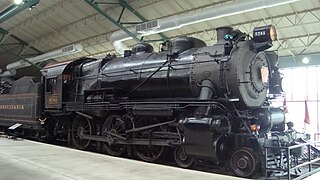
The Pennsylvania Railroad G5 is a class of 4-6-0 steam locomotives built by the PRR's Juniata Shops in the mid-late 1920s. It was designed for passenger trains, particularly on commuter lines, and became a fixture on suburban railroads until the mid-1950s.
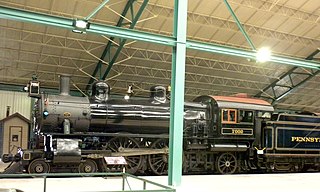
The Pennsylvania Railroad's class E2, E3, E7 steam locomotives were of the 4-4-2 "Atlantic" passenger type, frequently called light Atlantics after the introduction of the heavier E6 Atlantics. All were similar in size and boiler capacity but differed in firebox type, valves and valve gear and cylinder diameter. Classes E2 and E3 were built simultaneously.
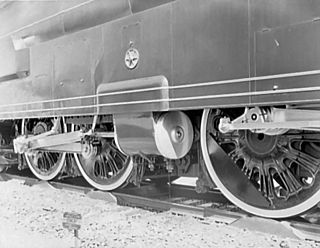
A duplex locomotive is a steam locomotive that divides the driving force on its wheels by using two pairs of cylinders rigidly mounted to a single locomotive frame; it is not an articulated locomotive. The concept was first used in France in 1863, but was particularly developed in the early 1930s by the Baldwin Locomotive Works, the largest commercial builder of steam locomotives in North America, under the supervision of its then chief engineer, Ralph P. Johnson.

Pennsylvania Railroad 5550 is a mainline duplex drive steam locomotive under construction in the United States. With an estimated completion by 2030, the locomotive will become the 53rd example of the Pennsylvania Railroad's T1 steam locomotive class and the only operational locomotive of its type, as well as the largest steam locomotive built in the United States since 1952. The estimated cost of PRR 5550 was originally $10 million, but an updated projected cost of $7 million was released with the acquisition of an existing long-haul tender from the Western New York Railway Historical Society in August 2017. Construction began in 2014 with the casting of the locomotive's keystone-shaped number plate. As of February 2024 the locomotive was 43% complete.
The Pennsylvania Railroad's class K29s comprised a single experimental 4-6-2 "Pacific" type steam locomotive. Constructed by Alco-Schenectady, it was given road number 3395. Although only one demonstrator was constructed, the K29s would become the basis for the highly successful K4s Pacifics and L1s Mikados. The lone example spent most of its life on the PRR's Pittsburgh division main line and was retired around 1929.
















